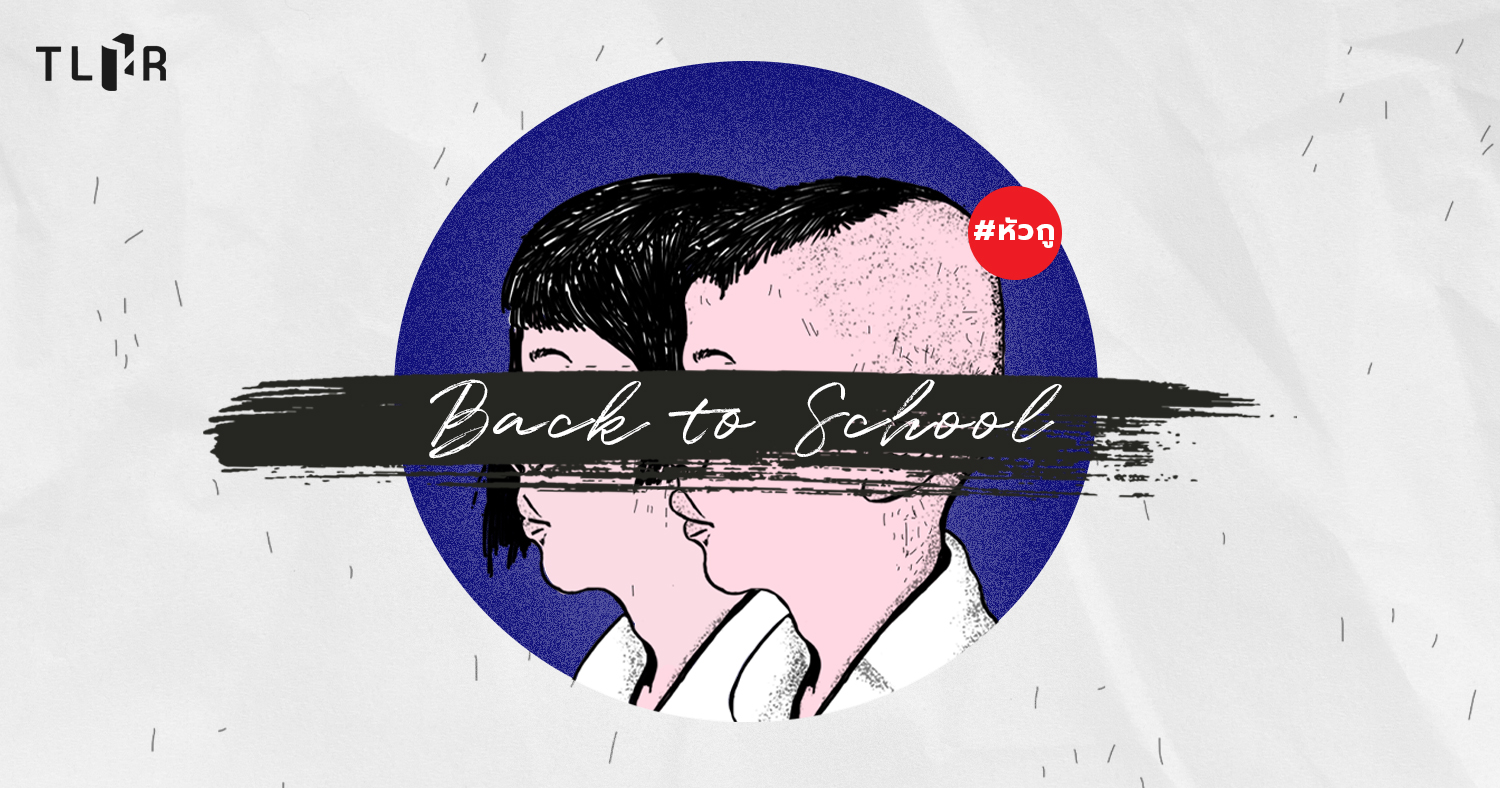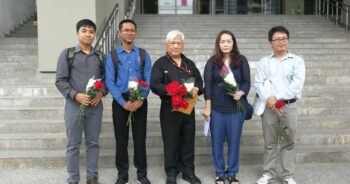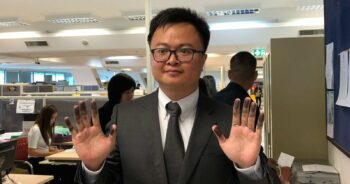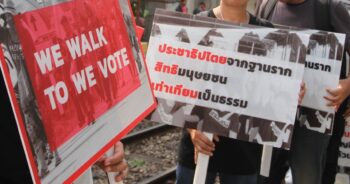Back to School: High school students filed lawsuits against Ministry of Education, demanding their rights over bodily integrity as teachers continue the practice of shaving off students’ hair
Since Monday 14 June 2021, students across Thailand returned to school upon the start of their first semester after the third wave of the COVID-19 outbreak, which began in April 2021. All schools currently implement hybrid teaching, combining both online and in-person classes. Nonetheless, students are still subject to stringent control over their bodily integrity in online classes. For example, some schools impose measures requiring students to continue wearing their uniforms or stand up and pay respect to the national flag at home in the same manner as to how they usually do at school. The “Bad Students” Facebook page reported that, during the semester’s first week, they have received 28 complaints about the school’s coercive measures on the students’ hairstyle, including a complaint that one teacher punished a student on his first day of school by shaving his head unevenly to humiliate him.
Meanwhile, from 17 to 18 June, several student activists organized symbolic activities to call for their right to self-determination. For instance, the “Revolutionizing Thai Education” Group organized the “Burn Useless Things” event in front of the Ministry of Education (MoE). During this activity, the participants set on fire the Regulation of the MoE on Students’ Hairstyle B.E. 2563 (2020) and the Draft Amendment of the National Education Act. Meanwhile, the “Bad Students” Group organized the “Power of Self-Identity” event to support people with any sexual orientations or gender identities. They also promoted the online use of the hashtag #MySexualOrientationIsMyF*ckingBusiness. This activity demonstrated the student activists’ persistent commitment to fighting against rules and norms that they regard as unfair and demanding their right to bodily integrity.
The students do not simply continue to organize symbolic protest activities from the entire year of 2020 to the start of the 2021 school year. One group of student activists has also been attempting to advocate for a concrete positive change. On 30 July 2020, representatives from the “Education for Liberation of Siam” Group, together with their lawyers, filed a lawsuit at the Central Administrative Court, petitioning the Court to consider revoking the Ministerial Announcement No. 2 B.E. 2518 (1975) issued under Announcement of the Revolutionary Council No. 132 dated 6 January 1975 and the MoE’s Regulation on Students’ Hairstyles B.E. 2563 (2020). The petition argued that these by-laws violate human dignity and contradict the Constitution.
A total of 23 students serves as the plaintiffs in this case. On the other hand, the MoE is Defendant No. 1, and the Minister of Education Defendant No. 2.
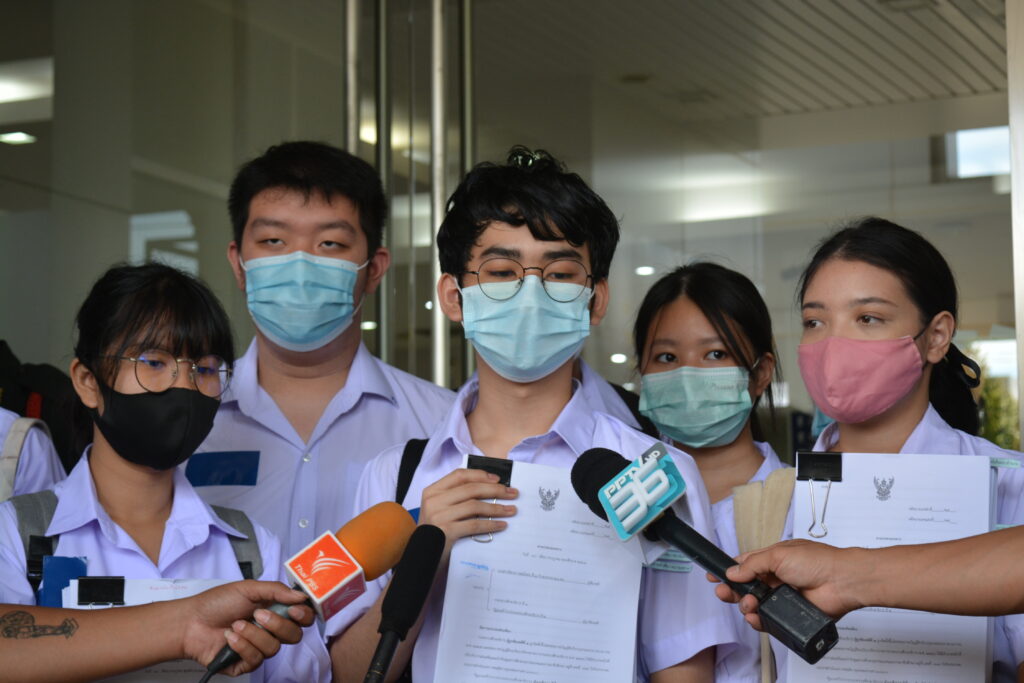
Photo of the representatives from the “Education for Liberation of Siam” Group on the date of filing their plaint to the Administrative Court on 30 July 2020
However, the Central Administrative Court only agreed to consider one of the petitions submitted by the 23 students; that is, the one requesting the Court to order the revocation of the MoE’s Regulation on Students’ Hairstyles B.E. 2563 (2020). As the Ministerial Announcement No. 2 B.E. 2518 (1975) is a ministerial regulation approved by the Cabinet, any cases related to this announcement must fall under the jurisdiction of the Supreme Administrative Court per Section 11(2) of the Act on Establishment of Administrative Courts and Administrative Courts Procedure B.E. 2542 (1999). As a consequence, the Administrative Court of First Instance could not accept to rule on this case.
For the case on the revocation of the MoE’s Regulation on Students’ Hairstyle B.E. 2563 (2020), both defendants requested the public prosecutor from the Office of the Attorney General (Department of Special Administrative Cases 6) to submit a challenge against the plaint. Subsequently, students who are the plaintiffs in this case granted their attorney the power to file an objection to the defendants’ testimonies. The next step in this legal proceeding is to wait and see whether the public prosecutor would file a supplementary testimony. Moreover, it remains to be determined whether the Administrative Court would summon the plaintiffs and defendants for a hearing or rule on the case solely based on the facts examined from documents submitted to the Court.
In the occasion of a new semester’s beginning for these students who are the future of our society, Thai Lawyers for Human Rights (TLHR) would like to present this article which will walk readers through key milestones of the students’ struggle for their right to bodily integrity, which has reached its halfway. This article will also further explore legal arguments to demonstrate the importance of revoking the which restricts the students’ rights to bodily integrity and constitute a serious violation of their human dignity because it objectifies students and deprives them of human agency. The information presented in this article shall serve as a solid foundation for our monitoring of how the remaining half of this battle will unfold.
Timeline of the progress in filing lawsuits to petition the Administrative Court to revoke regulations on students’ haircut
Testimonies from the defendants – the MoE and Minister of Education
On 10 February 2021, Athikrai Suwankeeree, a public prosecutor from the Department of Special Administrative Cases 6, acted as an attorney representing the defendants – the Minister of Education and MoE – to file the defendants’ testimonies and challenge the plaint. The testimonies provided facts about the legal status of both defendants and the background behind the issuance of MoE’s Regulation on Students’ Hairstyles B.E. 2563 (2020), as well as presented 4 legal arguments as follows:
Argument No. 1: The 23 plaintiffs claimed that the MoE’s Regulation on Students’ Hairstyles B.E. 2563 (2020) violates legal provisions under the Constitution of the Kingdom of Thailand, which guarantees the protection of rights and liberties for the people (Referring to those of the students in this case)
The defendants insisted that this regulation only has a legal status as an internal measure of the administrative branch used to arrange the status and relationship between the MoE and educational institutions affiliated with and under the supervision of the Ministry. The measure helps the Ministry determine actions related to students’ wearing of their hairstyles and the participation of students, educational institutes, parents, and local communities in shaping relevant rules. Its objective is to improve students’ disciplines and personality, which aligns with the Ministry’s legal responsibility in educational administration as prescribed under Section 40 of the Reorganization of Ministry, Sub-Ministry, and Department Act, B.E. 2545 (2002).
Upon considering the principle of proportionality, the defendants argued that this measure prescribed in the said regulation is necessary to protect students’ rights and ensure a uniform practice among all educational institutions. It was also stated that this measure has minimal impacts on the students, encourages student participation, and benefits the public by making educational institutions free from human rights violations and protects the students’ human dignity.
Without an official direction or standard, educational institutions could have developed different practices that could adversely impact students. Accordingly, the measure under this regulation should be considered appropriate and proportionate.
The MoE’s Regulation in question classified students into two categories: “Male students” and “female students.” This classification stems from the sociological differences between male and female students in Thai society. Any reasonable person would recognize how female students should wear their hair not much longer than the nape of their neck so that the hairstyle appears appropriate for students. On the other hand, it is only appropriate for male students to wear their hair no longer than the back of their neck. Taking into account these essential differences, the separation of rules between the mandatory hairstyles of male and female students shall be considered fair and justifiable discrimination.
Furthermore, some students who identify as LGBTQ+ have the ability to determine an appropriate hairstyle upon having a joint discussion among their educational institutions, their parents, and themselves. Therefore, the MoE’s Regulation already outlines conditions and directions suitable for different gender statuses and appropriate for students. Consequently, it is neither discriminatory nor unfair in any manner.
Argument No. 2: The 23 plaintiffs claimed that the MoE’s Regulation on Students’ Hairstyles B.E. 2563 (2020) violates Sections 6 and 7 of the National Education Act B.E. 2542 (1999).
The defendants testified that the National Educational Act has been enacted to govern national-level education, especially public educational services. The law does not contain any provisions related to students’ dress codes or hairstyles. Meanwhile, the MoE’s Regulation is an internal measure of the administrative branch used to determine an official standard of students’ hairstyles and provide a clear direction for educational institutions’ management of this matter. It serves to protect the students’ rights by preventing educational institutions from engaging in unstandardized practices that are not prescribed by the regulation. Accordingly, the said regulation does not contain any content that violates or contradicts the National Educational Act. The spirit and rationale behind the legislative processes of both documents were different. Moreover, the Ministry did not promulgate the regulation with the legal basis of any provisions under the National Educational Act.
In addition, when considering the substance of this regulation, the defendants found that it does not contradict Sections 6 and 7 of the National Education Act in any manner. To elaborate further, compliance with this regulation will help instill good conscience in students and equip them with knowledge, understanding, and the correct senses of morality related to their rights, duties, liberties, and responsibilities to respect the law. Ultimately, this will enable the students to co-exist with other people in society happily.
Argument No. 3: The 23 plaintiffs claimed that the Minister of Education’s exercise of his discretion to issue the MoE’s Regulation on Students’ Hairstyles B.E. 2563 (2020) was unlawful or erroneously used a wrong legal basis for such issuance.
The defendants stated in their testimonies that, in 2012, the National Human Rights Commission passed a resolution to provide policy recommendations to the Cabinet, proposing the MoE to review and amend ministerial regulations related to students’ hairstyle to ensure rights and liberties enshrined under the 2007 Constitution and guaranteed and protected under Thailand’s international human rights obligations. Consequently, in line with the recommendation from the Cabinet’s Secretary-General, the MoE agreed to invoke its power under Section 12 of the Administrative Organization of the MoE Act B.E. 2546 (2003) to issue the MoE’s Regulation on Students’ Hairstyles. It was intended that this regulation possesses a legal status as an internal measure of the administrative branch within the Ministry.
Therefore, the issuance of the MoE’s Regulation on Students’ Hairstyles under Section 12 of the Administrative Organization of the MoE Act B.E. 2546 (2003) must be regarded as the exercise of administrative powers within the MoE. The regulation serves as an internal measure of the administrative branch for increasing the performance of the MoE’s duties specified under Section 20 of the State Administration Act B.E. 2543 (2000). Thus, this process is lawful and did not involve any erroneous use of a wrong legal basis in any way.
Argument No. 4: The 23 plaintiffs claimed that the MoE’s Regulation on Students’ Hairstyles B.E. 2563 (2020) violated the United Nations Convention on the Rights of the Child
The defendants testified that the United Nations Convention on the Rights of the Child is an international convention to which Thailand is a State Party. Essentially, it aims to protect the bodily integrity, life, freedom, and well-being of children. On the other hand, the MoE’s Regulation on Students’ Hairstyles B.E. 2563 (2020) is an internal measure of the administrative branch used to arrange the status and relationship between the MoE and educational institutions affiliated with and under the supervision of the Ministry. The regulation helps the Ministry determine standard measures for governing students’ hairstyles. Applying such standard measures to all educational institutions will ensure that the hairstyles are appropriate for children of different ages and educational level, help students behave correctly, and protect human dignity.
The ministerial regulation in question does not contain clauses that provide for penalty for non-compliance or pose any danger to children. Therefore, it does not violate any dimension of rights guaranteed under the United Nations Convention on the Rights of the Child. It also does not contradict the overall essence of the rationale undergirding the United Nations Convention on the Rights of the Child.
At the end of their testimonies, the defendants asserted that the aforementioned arguments demonstrated that the issuance of this regulation is lawful. Therefore, they requested the Court to consider dismissing this case.
Objections from students who filed this lawsuit
After the public prosecutor acted as an attorney representing both defendants – the MoE and Minister of Education – to file their testimonies, a lawyer representing the 23 students who are plaintiffs in this case filed an objection against those testimonies. The objection offered both counter facts and legal arguments in response to the defendants and requested the Court to order the revocation of the MoE’s Regulation on Students’ Hairstyle sB.E. 2563 (2020). Below is the summary of the objection submitted by the students who filed this lawsuit.
1. The MoE’s Regulation on Students’ Hairstyles B.E. 2563 (2020) was an administrative act because its impact restricts the rights and liberties of students who are not persons under the MoE’s supervision under the law.
The defendant had claimed that the MoE’s Regulation on Students’ Hairstyles is a mere internal measure for the administrative branch. However, the plaintiffs argued that this regulation constituted an administrative act because its effects extend beyond the administrative branch. Notably, its enforcement results in the increasing restrictions of students’ rights to bodily integrity and liberties to improve their personality guaranteed under Sections 25 and 28 of the Constitution of the Kingdom of Thailand B.E. 2560 (2017).
Under the principles of administrative law, an internal measure for the administrative branch shall only be issued for internal management of administrative functions and only take effect within the branch. However, the scope of this regulation applies to other juristic persons who are not under the supervision of the MoE. Such persons include various private schools and individual students who encounter restrictions over their fundamental constitutional rights.
If this regulation was intended to serve as an internal measure for the administrative branch, the Ministry should have only created a letter for internal circulation to inform sub-organizations under the Ministry about this change, rather than issued it in the form of ministerial regulation.
2. The MoE’s Regulation on Students’ Hairstyles contradicts the National Education Act because the administrative branch must comply with higher laws, even though the regulation was not issued by invoking the power under the National Educational Act. Further, compliance with the regulation will destruct students’ good conscience and awareness about rights and liberties, which the National Educational Act aims to promote.
Under the principle of legality of administrative actions, the administrative branch must ensure that the performance of their duties conforms with the law (L’obligation de conformité). This principle dictates that any administrative acts shall not violate or contradict laws in a higher position in the legal hierarchy in any legal system, be it the Constitution or acts. The administrative branch must respect this principle, even though their subordinate administrative laws were not issued based on the powers granted under those higher laws or address different issues.
Consequently, it was invalid for the defendants to have argued the MoE’s Regulation on Students’ Hairstyles does not contradict the National Education Act because the regulation was not issued under the powers of this Act, and the National Education Act was legislated with a different spirit and rationale.
Furthermore, Sections 6 and 7 of the National Education Act provide a general principle that public educational services must promote rights, freedom, and human dignity. However, compliance with this regulation would restrict students’ conscience in all areas and hinder their liberty and bodily autonomy to make fundamental decisions about their hairstyles. Moreover, there is no rational correlation between complying with the regulation on the hairstyles and students’ ability to respect the law or co-exist with others happily. For instance, some private schools that allow students to choose their hairstyles freely, such as Amatayakul School, still manage to produce graduates who do not lack consciousness about the principles laid out in Sections 6 and 7 in any manner.
3. The MoE’s Regulation on Students’ Hairstyles is disproportionate and contradicts Section 26 of the 2017 Constitution because the objective of its issuance is illegitimate. The regulation could have included less restrictive measures and prohibited schools from imposing rules on students’ hairstyles.
Section 12 of the Administrative Organization of the MoE Act B.E. 2546 (2003), which was used as a legal basis for issuing the Ministry’s Regulation on Students’ Hairstyles, only intends to grant the Minister of Education the authority to issue rules for the internal management of the Ministry. Therefore, the regulation’s specified objective to create official standards for different schools in governing students’ hairstyles exceeds the scope provided under the law and is illegitimate under the principle of proportionality. The plaintiffs also argued that the regulation contradicts the principle of necessity, a sub-category under the principle of proportionality.
In addition, in response to the defendants’ claim that the issuance of this regulation was the measure that least affected students’ rights, the defendants argued that the administrative branch or the MoE could have come up with a less restrictive measure in terms of setting common standards on governing students’ hairstyles. For example, the Ministry could order that all schools not impose any rules on students’ hairstyles altogether. The plaintiffs viewed that this regulation does not respect the principle of necessity because there are still other ways to ensure minimal impacts on people’s rights. For these reasons, the MoE’s Regulation on Students’ Hairstyles B.E. 2563 (2020) could be regarded as contradictory to the principle of proportionality andSection 26 of the Constitution.
4. The MoE’s Regulation on Students’ Hairstyles violates the principle of equality enshrined in Section 27 of the 2017 Constitution because it prescribes that males and females must wear different hairstyles. Following such forceful imposition of gender differences should not be an essential requirement for students.
The core requirement for students is to immerse themselves in learning and to exercise their freedom to pursue the improvement of their potentials and fulfill the meaning of their lives, no matter what the students’ gender identities or sexual orientations are. The defendants’ testimonies referred to the Thai society’s particular characteristics and mentioned that any reasonable person should know how long the hair of female or male students should be. This rationale was cited to justify that the MoE’s Regulation on Students’ Hairstyles does not violate the principle of gender equality because it practices differential treatment with different groups of students who have distinctive essences. The plaintiffs, however, do not think that this argument is sufficiently solid and worth the Court’s consideration because such forceful imposition of gender differences should not be an essential requirement for students. According to the Supreme Administrative Court’s Ruling No. Aor 142/2547 (2004), education is the integral component of one’s status as a student. Therefore, the requirement for men and women to wear their hair differently contradicts the principle of equality enshrined in Section 27 of the Constitution.
The plaintiffs observed that the ministerial regulation in question is similar to an announcement issued by the Chiang Mai Municipal Office to allow only heterosexual men and women to join the Loy Krathong Festival parade, which deliberately excludes LGBTQ+ citizens. The Chiang Mai Administrative Court had ruled that this announcement violates the principle of equality guaranteed under the Constitution, despite acknowledging the importance of considering social and local traditions (Verdict of the Chiang Mai Administrative Court in Red Case No. 211/2554).
In their testimonies, the defendants explained that the MoE’s Regulation on Students’ Hairstyles does not violate the principle of equality because each school enjoys a margin of discretion to implement an exemption for this rule upon a joint agreement between parents, students, and school authorities. However, the plaintiffs maintained that the enforcement of this regulation to impose standards on students’ hairstyle generally still constitutes a violation of the principle of equality under the Constitution. Even though there could be some exceptional cases, such exceptions do not generally apply, unlike the standards prescribed in the regulation. Accordingly, the room of exemption in specific cases could not be regarded as a sufficient justification for turning this regulation from a by-law that has a severely unfair and discriminatory impact into one that is compliant with the constitutional principle of equality.
5. The MoE’s Regulation on Students’ Hairstyles violates human dignity because it objectifies students and deprives them of human agency.
The defendants asserted that the administrative branch issued this regulation intending to protect human rights and human dignity. However, the plaintiffs viewed that those goals were mere recommendations entirely based on the social understanding that students must wear appropriate hairstyles and adhere to gender binarism. This assumption reflects the lack of proper knowledge and ignores the liberties to develop one’s personality, which is part of the general liberties guaranteed under Section 25 of the Constitution. Therefore, the Court should not admit the testimony that claims the regulation does not violate human dignity or human rights.
The plaintiffs view that the regulation also violates human dignity because it deprives the students of the ability to make a decision on one of the most fundamental aspects of their bodily integrity; that is, their hairstyles. This regulation, therefore, objectifies the students, violates human dignity, and restricts the general liberties and the right to bodily integrity guaranteed under Sections 25 and 28 of the Constitution, respectively.
6. The invocation of Section 12 of the Administrative Organization of the MoE Act to issue the MoE’s Regulation on Students’ Hairstyles is unlawful because it does not serve the public interests as required by the Act and violates the “No legislation, no power” principle
The defendants mentioned that the invocation of Section 12 of the Administrative Organization of the MoE Act B.E. 2546 (2003) to issue the MoE’s Regulation on Students’ Hairstyles was lawful because the regulation aims to enhance the MoE’s performance of its duties under Section 20 of the State Administration Act B.E. 2543 (2000). However, the plaintiffs objected that Section 12 of the Administrative Organization of the MoE Act grants the authority for the administrative branch to make decisions regarding its internal management, and such decisions shall only take effect internally and do not extend its powers beyond the branch. Some examples of such decisions include the MoE’s issuance of regulation to allow civil servants of the Ministry to continue higher education and participate in training inside the country.
Section 12 granted this power to the Minister with the intention to permit the exercise of the ministerial authority to serve public interests by enhancing internal management within the administrative branch. Therefore, the defendants have used an erroneous legal basis by invoking the power under Section 12 to issue the MoE’s Regulation on Students’ Hairstyles and enforce it with general applicability for all students and educational institutions under the Ministry’s supervision. Therefore, this exercise of discretion is illegal and does not serve the public interests in the same spirit as given by the law.
Similarly, under Section 20 of the State Administration Act, the Minister shall only use his powers to serve the public interests by enhancing the administrative management of his Ministry’s internal functions, not to issue generally applicable regulations that restrict students’ liberties.
The plaintiffs, therefore, argued that the defendants violated the “No legislation, no power” principle, which is an essential principle in administrative law for protecting people’s rights and liberties and upholding the rule of law. Furthermore, the defendants abused their discretion by exercising it in a manner that does not serve the public interests as determined by the legislative acts. Accordingly, the MoE’s Regulation on Students’ Hairstyles should be considered an unlawful administrative act.
7. The MoE’s Regulation on Students’ Hairstyles violated the United Nations Convention on the Rights of the Child because it restricts students’ rights and liberties, and those who violated the regulation would be subject to punishment under the MoE’s Regulation on the Punishment of Students.
The defendants said in their testimonies that the MoE’s Regulation on Students’ Hairstyles does not violate the United Nations Convention on the Rights of the Child because it intends to protect children and does not contain any penalty for violators. The plaintiffs objected that even though the regulation stated its objective to protect students’ human dignity, its substance, whose provision imposes rules on hairstyles, still restricts students’ right to bodily integrity and freedom to pursue self-improvement. Thus, the plaintiffs insisted that this regulation violated the United Nations Convention on the Rights of the Child, especially in terms of the children’s right to enjoy self-improvement.
Although the regulation does not prescribe any penalty, students who violate it will automatically be subject to punishment under the MoE’s Regulation on the Punishment of Students.
Therefore, it is not true to state that “the MoE’s Regulation on Students’ Hairstyles does not violate the United Nations Convention on the Rights of the Child” because it carries no punishment. In reality, all students are, to a certain extent, subject to sanctions under the MoE’s Regulation on Students’ Hairstyles.
At the end of the objection petition from students who filed this lawsuit, it writes, “According to the Supreme Administrative Court’s Ruling No. For 11/2558, what affirms our humanity is the freedom that could not be compromised. The freedom to choose is, therefore, the most fundamental element that characterizes our humanity. Therefore, for the reasons mentioned above, the plaintiffs request the Court to order the revocation of the MoE’s Regulation on Students’ Hairstyles B.E. 2563 (2020) to protect the constitutional rights and uphold the rule of law for students subject to this unfair regulation.”
Currently, some students who filed this lawsuit against the MoE and the Minister of Education have become defendants in another political case. Benjamaporn “Ploy” Niwat from the “Bad Students” group and Kanapot “Poom” Yaemsa-nguansak from the “Free Students” group have been indicted by the public prosecutor at the Central Juvenile and Family Court for alleged violations of the Emergency Decree during their participation in the #15OctGoToRatchaprasong Rally. Both of them, therefore, are subject to the burden of fighting this legal battle in the Juvenile and Family Court. Although they became defendants in another case and had to fight the lawsuit, they persistently continue to fight for the right to bodily integrity for all students without giving up.
Constitution of the Kingdom of Thailand, B.E. 2560 (2017)
Section 25: As regards the rights and liberties of the Thai people, in addition to the rights and liberties as guaranteed specifically by the provisions of the Constitution, a person shall enjoy the rights and liberties to perform any act which is not prohibited or restricted by the Constitution or other laws, and shall be protected by the Constitution, insofar as the exercise of such rights or liberties does not affect or endanger the security of the State or public order or good morals, and does not violate the rights or liberties of other persons.
Section 26: The enactment of a law resulting in the restriction of rights or liberties of a person shall be in accordance with the conditions provided by the Constitution. In the case where the Constitution does not provide the conditions thereon, such law shall not be contrary to the rule of law, shall not unreasonably impose burden on or restrict the rights or liberties of a person and shall not affect the human dignity of a person, and the justification and necessity for the restriction of the rights or liberties shall also be specified.
The law under paragraph one shall be of general application, and shall not be intended to apply to any particular case or person.
Section 27: All persons are equal before the law, and shall have rights and liberties and be protected equally under the law.
Men and women shall enjoy equal rights.
Unjust discrimination against a person on the grounds of differences in origin, race, language, sex, age, disability, physical or health condition, personal status, economic and social standing, religious belief, education, or political view which is not contrary to the provisions of the Constitution, or on any other grounds shall not be permitted.
Section 28: A person shall enjoy the right and liberty in his or her life and person.
Administrative Organization of the MoE Act B.E. 2546 (2003), Section 12: The Minister of Education shall act as the Chief of civil servants in the Minister of Education and be responsible for formulating the Ministry’s policies, objectives, and targeted accomplishments to be compliant with the policy directions addressed by the Cabinet before the Parliament or those determined or approved by the Cabinet. There may be a Deputy Minister of Education to provide assistance in giving orders and performing the said functions.
State Administration Act B.E. 2543 (2000), Section 20: Subject to the provisions of section 11, in a Ministry, there shall be one Minister being the Chief of civil servants and responsible for formulating policies, objectives, and targeted accomplishments of that Ministry to be compliant with the policies addressed by the Cabinet before the Parliament or those determined or approved by the Cabinet. There may be Deputy Minister to assist in giving orders and performing the said functions.
